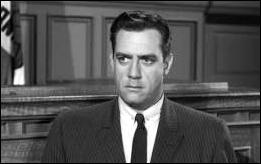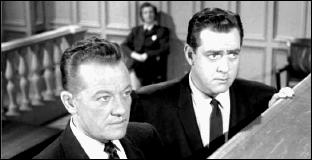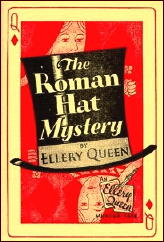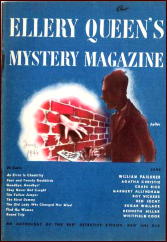Fri 6 Apr 2012
Mike Nevins on the PERRY MASON theme, ELLERY QUEEN and WILLIAM FAULKNER.
Posted by Steve under Authors , Columns , TV mysteries[12] Comments
by Francis M. Nevins
When stuck for something to write about, browse the Web. I did that recently and discovered on the Bernard Herrmann Society website an excellent item to kick off this column with, an interview with composer Fred Steiner (1923-2011), whose main claim to fame for mystery lovers is that he wrote the theme for the Perry Mason TV series, which you may listen to here.

Here, laboriously transcribed by my own fingers, is what he had to say on that subject in the 2003 interview:
“I think the first time we recorded it, of all things, was in Mexico City, because of union complications. The original title was ‘Park Avenue Beat.’ And the reason for that was, I conceived of Perry Mason as this very sophisticated lawyer, eats at the best restaurants, tailor-made suits and so on, and at the same time he’s mixed in with these underworld bad guys, murder and crime.
“The underlying beat is R&B, rhythm and blues, and for the crazy reason that in those days, and even to this day, jazz or R&B is always associated with crime. You look at those old film noir pictures, they’ve always got jazz going for some reason or other. It’s like every time you see a Nazi they play Wagner.
“[The theme is] a piece of symphonic R&B. That’s why it’s called ‘Park Avenue Beat,’ but since then it’s been known as the Perry Mason theme… It’s always been used. It’s gone through several changes depending on the timing, because they would change the main titles year in and year out.â€

During the late Fifties and early Sixties when Perry Mason was in prime time, the head of the CBS west coast music department was Lud Gluskin (1898-1989) and the best-known composer working for him of course was Herrmann (1911-1975), whose ominous music was heard frequently in the episodes from the first two years of the series.
Steiner went on to tell of another Herrmann-Mason connection:
Listening to Steiner’s words as Perry Mason would listen to the testimony of a witness against his client, do you detect the ambiguity I do? If Steiner were on the stand and you were cross-examining him, wouldn’t you ask the same question I would?
“Mr. Steiner, do you know whether Herrmann actually wrote a new theme for the series before he persuaded his bosses that they didn’t need one?â€
Steiner died last June so the answer may never be known. But if he had replied that Herrmann did indeed write such a theme, wouldn’t you love to knew where it is? Or better still, to hear it?
At least we can see Steiner and hear the interview on YouTube.

From the Fifties let’s retreat to 1928, the year Fred Dannay and his cousin Manny Lee were writing The Roman Hat Mystery and creating Ellery Queen. How did they come up with the name?
It’s been known for decades that Ellery was the name of Fred’s closest friend when he was growing up in Elmira, New York. How they settled on Queen was explained in an audio recording played at the Columbia University’s Queen centennial conference in 2005.
The speaker is Patricia Lee Caldwell (1928- ), Manny’s oldest daughter, who had the story from her mother, Manny’s first wife, Betty Miller (1909-1974). Manny had married her in 1927 when she was 18 years old and he was 22. They were living in an apartment on Ocean Avenue in Brooklyn when their daughter was born.
“They had already decided on Ellery … but they hadn’t decided on a last name. Well, they were playing cards, and my mother said that they suddenly looked at the picture cards and they said: ‘Yeah, wait, the picture cards. Maybe this will give us something.’
“And they suddenly decided it would be Ellery King … but it didn’t seem quite right, and so they diddled around with it a little and they said: ‘No, Queen. Queen!’ The letter Q is extremely unusual in the English alphabet, and it would be much more memorable.â€
And which of us shall say that it wasn’t?

Now let’s jump forward to a time when Ellery Queen was a household word, specifically to the fall of 1946 when the first volume of The Queen’s Awards brought together the prizewinners in the first annual story contest that Fred Dannay conducted for Ellery Queen’s Mystery Magazine.
Among the winners of the six second prizes — $250 apiece, which was a nice chunk of money in those days — was William Faulkner for “An Error in Chemistry†(EQMM, June 1946), the future Nobel laureate’s only original contribution to the magazine. (The two other Faulkner stories Fred bought were reprints.)
From various Faulkner biographies we learn that he lost no time deriding both the magazine and the prize. “What a commentary,†he wrote his agent. “In France I am the father of a literary movement. In Europe I am considered the best modern American and among the first of all writers. In America I eke out a hack’s motion picture wages by winning second prize in a manufactured mystery story contest.â€
A true Southern gentleman, yes?
April 6th, 2012 at 11:18 pm
I had to laugh when I read the story about William Faulkner. He then went on to win the Nobel Prize for Literature in 1949. But it sounds like he has the opinion that mystery stories are “sub-literary”. This was fairly common in the 1940’s and Edmund Wilson wrote three articles for the NEW YORKER; one titled “Who Cares Who Killed Roger Ackroyd”, which just about sums up his stand.
By the way, the April 1946 EQMM states the second prizes as being worth $500 each, not $250. The first prize received $2000, which in 1946 money is worth about $20,000 today. Big money indeed for a short story in a mystery digest.
I found the announcement of the winners in the April 1946 issue. There were 838 submissions and the final 15 is quite a list of well known authors:
First Prize–Manly Wade Wellman
Second Prizes–William Faulkner, Helen McCloy, Philip Macdonald, T.S. Stribling, Manning Coles, Anthony Gilbert.
Third Prizes–Ngaio Marsh, Q. Patrick, Michael Innes, Craig Rice.
Fourth Prizes–Kenneth Millar, Jerome and Harold Prince, Francis Crane, Clifford Knight.
April 6th, 2012 at 11:28 pm
As for your question of the witness.
Perry, having won the trial, is in his office. He explains to Paul Drake, as he usually has to explain something to Paul Drake.
It is unlikely Herrmann would have taken the time to write a theme song without checking the original. If he had written a theme song he would not have told them not to use it. And if he had written a theme song, realized it was not needed, Mr. Herrmann would have done what Mr. Steiner did. Give it another name and published it for something else.
Now Paul, you owe Della and I dinner.
Nice fun post, Mike.
April 7th, 2012 at 4:32 am
Faulkner made disparaging comments about Sanctuary too, of course. He obviously liked the mystery structure, however.
April 7th, 2012 at 1:32 pm
Great detective work, Walker!
Looking through that complete list of winners:
Had he but known, Faulkner was in great company at the time. But it’s obvious he had higher aspirations, which all credit to him, he accomplished, and then some.
April 7th, 2012 at 2:29 pm
The judges were divided on that particular EQMM contest. I can’t remember how many judges there were, but the story goes that each judge had picked a different story for first place and couldn’t come to an agreement. They then polled themselves as to which story each thought was second best and the Wellman was the unanimous choice, so they gave first prize to Wellman.
April 7th, 2012 at 2:37 pm
There were three judges according to the statement issued in the April 1946 EQMM. Howard Haycraft, author of MURDER FOR PLEASURE; Christopher Morley, member of the Editorial Board of The Book Of the Month Club; and Ellery Queen.
April 8th, 2012 at 6:06 am
Faulkner did like mysteries – he owned books by Rex Stout, John Dickson Carr and Ellery Queen among others. I guess his reaction reflected his frustration at not being taken seriously in his own country rather than a downright rejection of the genre.
April 9th, 2012 at 8:21 pm
Jorge Luis Borges also won a second-prize from EQMM for one of his short stories, so they did their bit for capital-L Literature
April 10th, 2012 at 8:54 am
There are variations on the story where Faulkner is making such a drunken voluble ass of himself at the ceremony that Wellman is moved to ask him if he needed to step outside (whether to compose himself or simply because he’d gotten sufficiently under Wellman’s skin varies from account to account). That Faulkner is still willing to slur Wellman, who was no hack to say the least, after the fact might indicate just how obnoxious Faulker was at the time.
April 10th, 2012 at 8:56 am
Ah, read that too quickly. But Faulkner no doubt never apologized for such behavior, even if here he doesn’t actually insult Wellman directly.
April 10th, 2012 at 9:46 am
Great post(s). I love the work of Queen (Dannay and Lee), Herrmann and Faulkner almost without reservation – but it is clear that they could all be crotchety so and so’s when the mood hit them. Shame really.
April 10th, 2012 at 10:08 am
After I read this entry, I got to thinking about the way TV shows were scored during the ’50s and ’60s.
When I got home, I got out Martin Grams’s recently published book about The Twilight Zone, which has, among other interesting features, an episode-by-episode breakdown of the musical scores.
It seems that many if not most of the episodes had musical scores stitched together from multiple stock themes from the CBS music library; in addition to TZ, Rawhide, Perry Mason, and many other network-controlled productions drew from this music bank. Even as a kid, I would notice when Twilight Zone music would pop up on Rawhide – or vice versa.
So when Perry Mason solved “The Case Of The Glamorous Ghost” to music I’d heard on Twilight Zone, it seemed fitting.
If I’m wrong, please correct, but as I read Steiner’s story, it was Herrmann who told Steiner about being approached for a new Mason theme. This would correlate with an account on one of those TZ score albums that Herrmann was similarly approached by CBS to come up with a brand-new TZ theme when CBS was having trouble with fees to Marius Constant for his “deedle-deedle” theme; that was settled in Constant’s favor, and the new themes that Herrmann wrote went into the CBS music bank for use on TZ and elsewhere (one of the albums included two such themes; I recall at least one of them being used on the show).
If Bernard Herrmann did actually compose a potential new Perry Mason theme, it no doubt found a happy home in the background score of some other CBS production.
Perhaps one day Martin Grams will do a book on the Mason series, and then we can all find out.